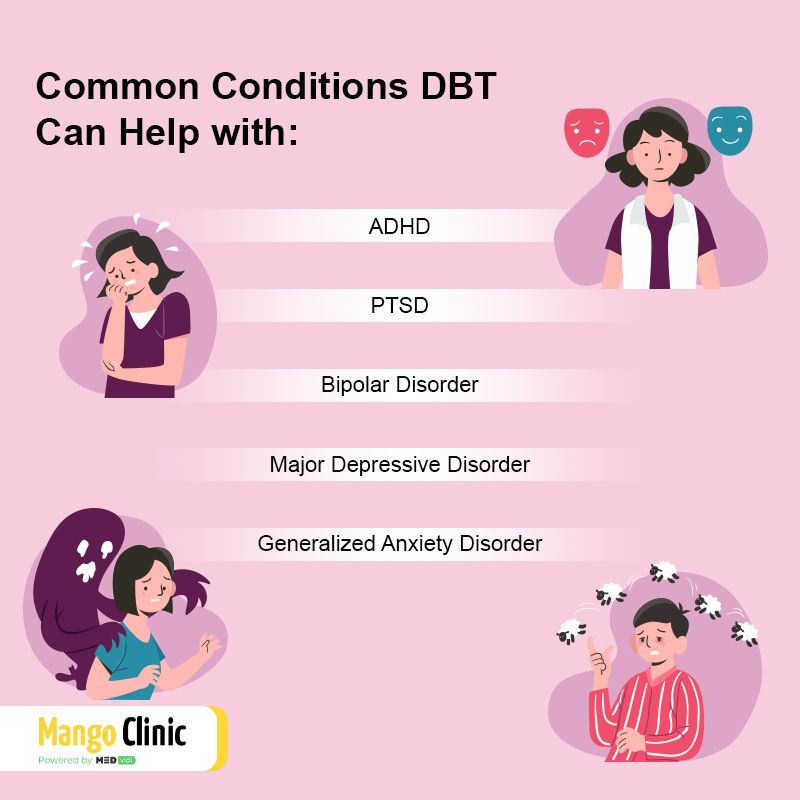5 Quick and Easy DBT Mindfulness Exercises

Mindfulness is one of the techniques used to overcome anxiety and stress. An anxious person experiences fear of what might happen in the future. But mindfulness trains you to focus on the present and minimize the worries of tomorrow.
Dialectical behavior therapy (DBT) aims at helping you understand and accept your current situation. It also makes you more willing to change for the better. DBT mindfulness exercises are the main types of treatment for people struggling with suicidal thoughts, self-harming behavior, addictions, and depression.
Whenever you feel stressed or tired and want to relax, you can practice DBT mindfulness exercises. But how do you do it? Below are five easy DBT mindfulness exercises that you can do from anywhere.
Dialectical behavior therapy can help you with mental health issues. Click the button below to book your appointment.
Table of Contents
1. Five Senses Exercise
This exercise presumes using your five senses to experience your surrounding environment. It’s a simple, 2-minute mindfulness exercise that you can do from any place. You can do it alone or as a group. Follow this order while doing the exercise:
- Identify five things you can see. These could be items in a house such as wall pictures. It could also be outdoor objects such as trees, clouds, birds, among other things.
- Identify four things you can feel. These are things you can experience with your body. For instance, they could be the texture of your clothes, the smoothness of a table, pain in your body, and more.
- Identify three things you can hear. It could be active listening from a distance, birds singing, a person talking, a car approaching, a dog barking, among other sounds.
- Identify two things you can smell. It could be a pleasant or unpleasant smell. Try to distinguish different types of scents. For instance, when you smell food, you can try to discern the various ingredients in the food.
- Identify one thing you can taste. For this exercise to work, you may need to drink or eat something at the moment. It could be something as simple as chewing gum or a soft drink. Try to identify the taste of the items.

2. Mindful Observation
Mindful observation requires you to set your full attention on an object that you can see. It could be an artificial or a natural object, a living or non-living thing. Look at the object as if you’re seeing it for the first time. Take your time and observe every aspect of it. Think about the purpose of the object, its appearance, its significance, etc.
The more you analyze the item, the more you forget about your anxiety. But be sure that the object you focus on isn’t threatening in any way. Every time you feel stressed or anxious, you can start practicing mindful observation to provide a distraction from your thoughts. These DBT mindfulness exercises can train you to have self-control and help you concentrate better on tasks.
A professional good counselor can help you with health restoration. Click the button below to book your appointment.
3. Mindful Immersion
A significant number of people don’t concentrate on what they do. Lack of concentration can result from stress. It can make you less efficient and deny you joy in your work. On the other hand, mindful immersion requires you to focus on every activity you do. Whether you’re reading a book, cooking food, or cleaning the house, you should observe your actions and get consumed by the moment.
Assume you’re doing the task for the first time. Listen to the muscles of your body and the motions they make. Get creative and find a more efficient way of doing the work. Don’t focus on finishing the task, instead engage yourself fully and take the activity beyond the routine. Even 5 minutes of mindfulness exercises can help you avoid stress and be more productive.

4. Cause and Effect Meditation
These dialectical behavior therapy mindfulness exercises are best done at the end of the day as they involve reflecting on what happened during the day. Best of all, you can even do them when resting in your bed. After all, it’s easier to reflect when your eyes are closed.
So, identify what you did during the day and the results of your actions. Be careful not to judge yourself. What are you proud of, and what do you regret? If you got a second chance, what would you do differently? Doing this exercise can help you become a better person by learning from your mistakes.
5. Mindful Breathing
When you get livid, you can make a split-second emotional decision that can ruin your life. What can help you avoid such situations? Try mindful breathing. These 1-minute mindfulness exercises can save you from making a hasty decision you’ll later regret. You always have your breath wherever you go. So this exercise is readily available when the need arises.
Whenever you experience an emotional burst, shift your focus immediately from your thoughts to your breath. Count your breaths or pay attention to each inhale and exhale. Mindful breathing can help avoid negative thinking and buy some time to transition into positive thinking.
DBT therapy sessions with a therapist can save you from chronic stress. Click the button below to book your appointment.
Get More Help on DBT Mindfulness Exercises
You may be incapable of changing your stressful life circumstances, but you can control stress and anxiety. You can do this by engaging in regular DBT mindfulness exercises. The exercises highlighted above are a few examples to help you get started. But if you need more help, you can get into DBT therapy.
If you’re looking for a professional therapist for DBT therapy, Mango Clinic can help you. We have licensed therapists with many years of experience treating anxiety, depression, and other mental problems. If you’d like to get started in online therapy sessions, contact us today or click the banner below to book your appointment.




